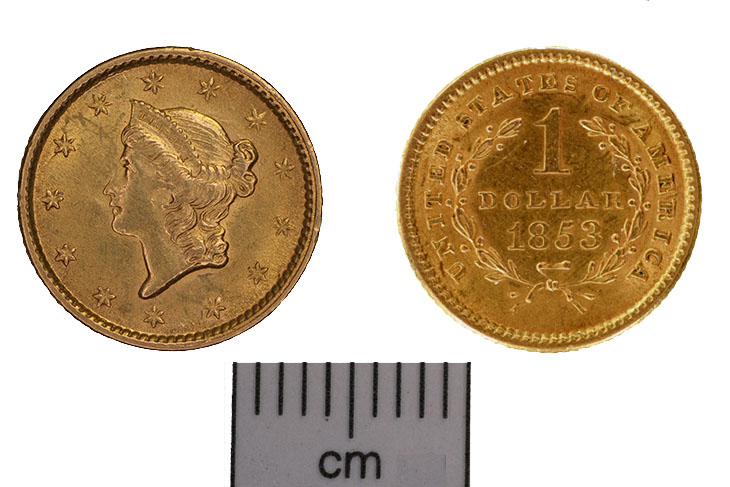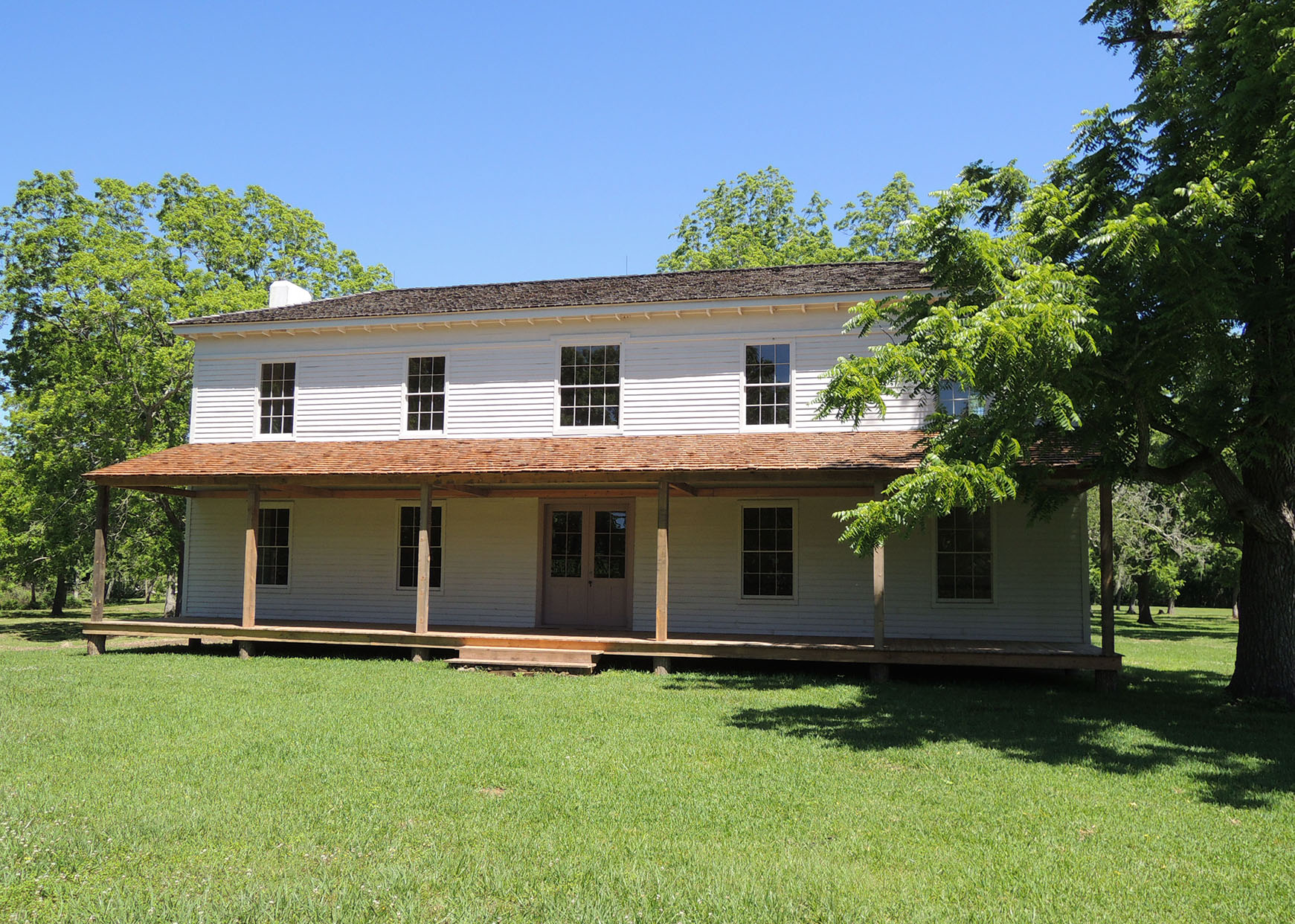
Object: Liberty Head one-dollar gold coin
Date: 1853
Context: Southeast Texas, Levi Jordan State Historic Site, Levi Jordan house foundation
Popular media frequently paints archaeologists as treasure hunters. In reality, the archaeologist's treasure is the information about the human past learned from the material culture and its context, most often the discarded refuse of everyday life and the sediments in which they were buried. This gold coin is an exception in that it satisfies popular notions of treasure and, more importantly, fills a hole in the historical record and illustrates the importance of context. The coin was purposefully sandwiched between the handmade bricks of Levi Jordan's house foundation at the start of its construction in 1853; the coin did not again shine in the light of day until 158 years later.
In 1848, Levi Jordan established a plantation in Brazoria County on the San Bernard River. Within a few years Jordan commissioned the construction of a two-story Greek Revival-style home at this location. The house weathered hurricanes, modifications and repairs, and the deterioration that come with 150+ years standing. In 2011, it was stabilized by the Texas Historical Commission (THC), who manage the Levi Jordan State Historic Site. Archaeological excavation of the house foundation was undertaken in 2010 and 2011, prior to stabilization, because the original foundation piers would be destroyed by construction of a new foundation. The excavations were conducted by Prewitt and Associates, working for the THC.

The antebellum house was constructed on pier and beam foundation. To allow for excavation beneath the house, the structure was lifted with jacks and supported six feet above ground on wooden cribbing; archaeologists excavated beneath the looming structure. The coin was found in the pier pad at the southeast corner of the house (right front corner when facing the house). The pier was a 2x2-ft square pad composed of three courses of handmade bricks with a 19.5-inch-diameter live oak timber on top. The bricks were almost certainly handmade by the enslaved African Americans who lived on the plantation. Four metal stakes were found around the pier and served as lightning grounding rods. The coin was found sealed between the lowest two courses of bricks. The coin precisely dates the beginning of the building construction to 1853—a fundamental piece of information that had been obfuscated by conflicting and vague historical records.
Previous estimates of the period of house construction were based on oral history from a descendant born after the house was constructed (“The frame residence, which was constructed in 1854, was made from oak timbers. … The house was under construction when the [July 1854] hurricane hit”), an 1857 letter penned by a visitor to the plantation (“The new house is almost done, it looks magnificent”), a Texas Historical marker (“Home built 1848-1851 by slave labor”), and the Brazoria County ad valorem tax records. The tax records show significant increases in the plantation's property value between the years 1853-1854, 1854-1855, and 1856-1857, assumed to correlate with the construction of the house, sugar mill, and other improvements. Historical marker aside, these sources indicate that the house was under construction by 1854 and was not fully finished in 1857 (though it is unclear whether the letter's “almost done” refers to the main structure, the addition of back wings, or addition of interior embellishments). The gold coin settled the construction start year, which is further supported by the change in property value between 1853 and 1854. It is surmised that the Jordan family probably was living in the house in 1855, but that additions and final touches continued to be added until 1857.
The significance of the gold coin extends beyond historical timelines, however. In the excavation report McWilliams et al. write,
it is argued that the coin was placed in a sacred spot in the structural foundation as part of a foundation ceremony or cornerstone rite. Such rites were common in many cultures around the world and are best represented by the traditions of the Freemasons.
While it is not known whether Levi Jordan or his master builder was a Freemason, it is known that the Freemasons were a powerful organization in the Republic of Texas and during early Texas statehood. By 1845 there were 25 masonic lodges established in Texas including one in Brazoria County. It is plausible that Jordan or his master builder was a Freemason and interred the coin as part of a cornerstone rite.
Historical accounts of the masonic cornerstone rite state that it served to provide “a soul for the structure.” These accounts describe the placement of items such as coins, photos, and newspapers in the foundation. Several accounts specify that interred coins are minted in the year of construction. A ceremony would typically follow the interment of the item(s), during which the foundation would be shown to be plumb, level, and square. Afterwards, the foundation would be consecrated with corn, wine, and oil. Several accounts suggest the consecration is an adaptation of a much older ritual involving animal or human sacrifice.
For archaeologists, the gold coin is the cornerstone (pun intended) for establishing the construction timeline for the Levi Jordan house. The coin's context also hints at the social and spiritual or religious belief system of Levi Jordan or his associates during the antebellum period in Brazoria County. Rich in information, this gold coin is undoubtedly an archaeological treasure. It is curated at the Texas Historical Commission's Archaeological Repository.
CreditsAdapted from McWilliams et al. 2013 by TBH Editorial Assistant Emily McCuistion with help from Doug Boyd. Images were provided by Sandy Hannum and J. Brett Cruse. Sandy and Doug work for Cox McLain Environmental Consulting. Brett is Director of Historic Sites Operations at the Texas Historical Commission.
Print Source
McWilliams, Jennifer K., Douglas K. Boyd, and Aaron Norment
2013 Archeological Investigations for the Levi Jordan Plantation House Stabilization, Brazoria County, Texas. Reports of Investigations, Number 166. Prewitt and Associates, Inc., Cultural Resources Services, Austin, Texas.